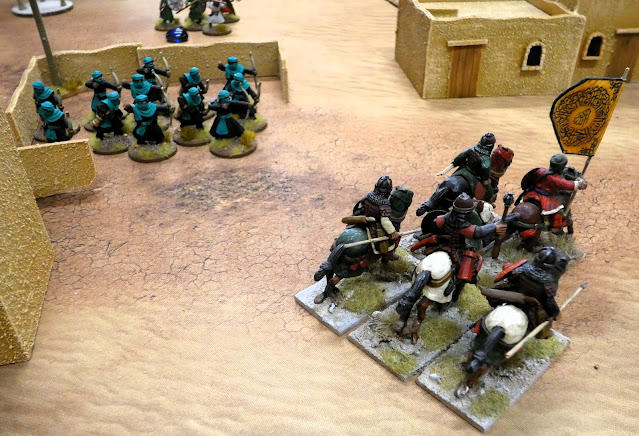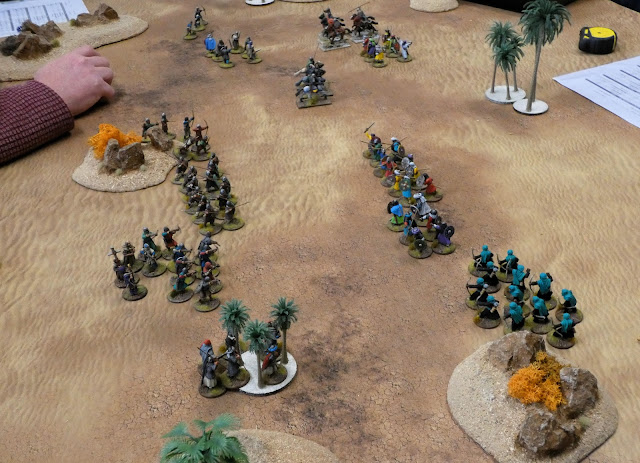The game was based on the third scenario from the new Lion Rampant rules titled "Defending the Indefensible".
The game takes place in and around a village in the Levant in the year 1098. An ambitious Bishop has decided to raise a very fancy large wooden cross in the village square. His intention is to attract more pilgrims to stop and worship and purchase religious artefacts.
Those containing pieces of the original cross are particularly popular and he has a seemingly endless supply of these. The local Emir, whose beloved mother was born in the village, is less than impressed and he has sent a force to enter the village (by force if necessary) and destroy the newly erected cross.
The village is defended by a Frankish force who have caught wind of the Emir's plan. Within the walls of the village are a unit of heavy infantry, a unit of crossbow men, two units of skirmishers and a unit of foot knights with their warlord.
The Bishop is also present and his religious fervour will boost the morale of the unit of heavy infantry that he is attached to. There are Frankish support units that enter from the north edge of the board at the start of the game. These comprise two units of mounted Knights and a unit of foot Knights.
The defenders notice a cloud of dust and sand in the distance and immediately rush to take up defensive positions. The skirmishers who are classed as "fast" are able to move through rough terrain unimpeded and they position themselves on the rooftops, with one unit on the western side and one on the eastern. Their armour increases from one to two against missiles and the added cover from the rooftop will raise it further to armour three.
The crossbows man the western front wall of the village, while the heavy infantry form up around the cross to protect it. The foot knights are near them ready to intercept any incursions.
Out of the cloud of dust and sand appears groups of Seljuk infantry, archers and cavalry. The infantry is made up of two units of elite foot (the equals to the Frankish foot knights) and two units of light infantry armed with javelins. The archer unit is armed with war bows that out distance the bows of the Frankish skirmishers. (The Frankish skirmishers are "Hard to Target" and so cannot be shot at by an enemy outside 12".
In addition to the infantry and archers, the Seljuk force contains three units of heavy cavalry all armed with bows that have a 12" range. What this force lacks in terms of heavy armour, it makes up for with missile weapons.
The Seljuks surge forward towards the village and their archers quickly start to target the unit of crossbows, but with little effect. Their light infantry units move forward on the left and right flanks supported by their cavalry. The two units of elite foot move towards the entrance to the village. One of the two Seljuk warlords notices that the entrance to the village has no barricade and he directs a unit of cavalry to attempt to enter through it. The mounted unit is slowed by the narrow archway forming the entrance to the village and is repulsed by the defenders.
The Frankish heavy infantry form a wall of spears around the cross. This will increase their armour by one in hand-to-hand. The Crossbowmen return fire on the Seljuk archers and there more powerful weapons cause some casualties, but the archers are undeterred and continue to move up to find a more advantageous position. The skirmishers on the rooftops fire down on an approaching unit of light infantry on the western side of the village causing some casualties, but the Seljuk foot continues towards the crossbowmen manning the front of the village.
The Frankish support units, hearing the noise of combat race towards the village. One unit of knights moves to the western side of the village and the other the eastern side. The unit of foot knights also moves towards the north eastern end of the village.
For the crossbowmen at the front of the village the situation is becoming desperate. They have started to take casualties from the Seljuk archers and are then assaulted by a unit of light infantry armed with javelins. There is a bloody fight at the wall and the crossbowmen recoil and are battered.
After the unsuccessful attack through the archway, a determined unit of elite foot together with a holy-man to boost their morale, successfully fight their way into the village and enter combat with the Frankish warlord and his unit of foot knights.
Meanwhile, outside the village each unit of Frankish Knights charge towards the mounted Seljuk heavy cavalry who fire their bows at the knights, but cause no casualties. The Knights hit them causing heavy losses.
All is certainly not going the Franks' way. Having been battered and thrown back from the walls, the crossbowmen take additional casualties and despite the proximity of their warlord they turn and flee from the village. With only the skirmishers to support him from the rooftops, the warlord and his Knights stand their ground and fight against the Seljuk elite foot and a unit of mounted heavy cavalry. They are wiped out, but the courage of the defenders remains firm. Seemingly, the warlord was not particularly popular with his men.
Just in time the support unit of elite knights enter the village as the Seljuk force turns its attention on the unit of heavy infantry protecting the cross. This unit, realising missile could soon be coming their way, changes formation to a shieldwall to improve its armour against both hand to hand and missile attack.
A unit of Seljuk light infantry now attempts to dislodge a unit of Frankish skirmishers from the roof of the building on the eastern side of the village. The "fast" skirmishers run from one roof top to another. The Seljuk infantry, encumbered by swords, shields and javelin are unable to follow. At the same time a unit of mounted Frankish Knights, now jumps a wall to enter the fray.
What follows is an almighty melee within the village. The Seljuk force throws all its might against the Frankish defenders and successive valiant attempts to reach the hotly contested cross are thrown back. The Frankish force has taken heavy losses, more than the attackers in fact, yet they still stand firm even after the loss of a warlord. The Seljuk force realises that it is never going to be able to reach that cross and they withdraw form the village.
The outcome of the battle:
Technically this was a Frankish victory, but it was a perfect example of a Pyrrhic one. Their force had lost a warlord and his unit of elite knights together with a unit of valuable crossbowmen and their heavy infantry was reduced by a third as were their skirmishers. Another determined attack by a Turkish force would inevitably see the village taken and the cross "removed".
Editors Note - Mike's game finished earlier than planned, so the chaps rearranged the table and set up a straight-forward open terrain battle to end the afternoon on and I include a couple more pictures from Mike's lovely collection of figures and terrain in action from that little clash.

















A great game report. Had it been part of a campaign, if I were the Christian commander I'd be seriously worried after this action.
ReplyDeleteQuite right, AJ. Thank you for your feedback.
ReplyDelete